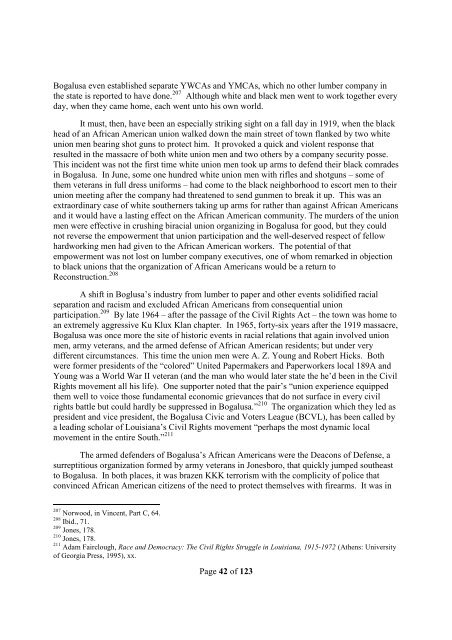The African American Experience in Louisiana
The_African_American_Experience_in_Louisiana
The_African_American_Experience_in_Louisiana
- No tags were found...
Create successful ePaper yourself
Turn your PDF publications into a flip-book with our unique Google optimized e-Paper software.
Bogalusa even established separate YWCAs and YMCAs, which no other lumber company <strong>in</strong><br />
the state is reported to have done. 207 Although white and black men went to work together every<br />
day, when they came home, each went unto his own world.<br />
It must, then, have been an especially strik<strong>in</strong>g sight on a fall day <strong>in</strong> 1919, when the black<br />
head of an <strong>African</strong> <strong>American</strong> union walked down the ma<strong>in</strong> street of town flanked by two white<br />
union men bear<strong>in</strong>g shot guns to protect him. It provoked a quick and violent response that<br />
resulted <strong>in</strong> the massacre of both white union men and two others by a company security posse.<br />
This <strong>in</strong>cident was not the first time white union men took up arms to defend their black comrades<br />
<strong>in</strong> Bogalusa. In June, some one hundred white union men with rifles and shotguns – some of<br />
them veterans <strong>in</strong> full dress uniforms – had come to the black neighborhood to escort men to their<br />
union meet<strong>in</strong>g after the company had threatened to send gunmen to break it up. This was an<br />
extraord<strong>in</strong>ary case of white southerners tak<strong>in</strong>g up arms for rather than aga<strong>in</strong>st <strong>African</strong> <strong>American</strong>s<br />
and it would have a last<strong>in</strong>g effect on the <strong>African</strong> <strong>American</strong> community. <strong>The</strong> murders of the union<br />
men were effective <strong>in</strong> crush<strong>in</strong>g biracial union organiz<strong>in</strong>g <strong>in</strong> Bogalusa for good, but they could<br />
not reverse the empowerment that union participation and the well-deserved respect of fellow<br />
hardwork<strong>in</strong>g men had given to the <strong>African</strong> <strong>American</strong> workers. <strong>The</strong> potential of that<br />
empowerment was not lost on lumber company executives, one of whom remarked <strong>in</strong> objection<br />
to black unions that the organization of <strong>African</strong> <strong>American</strong>s would be a return to<br />
Reconstruction. 208<br />
A shift <strong>in</strong> Boglusa’s <strong>in</strong>dustry from lumber to paper and other events solidified racial<br />
separation and racism and excluded <strong>African</strong> <strong>American</strong>s from consequential union<br />
participation. 209 By late 1964 – after the passage of the Civil Rights Act – the town was home to<br />
an extremely aggressive Ku Klux Klan chapter. In 1965, forty-six years after the 1919 massacre,<br />
Bogalusa was once more the site of historic events <strong>in</strong> racial relations that aga<strong>in</strong> <strong>in</strong>volved union<br />
men, army veterans, and the armed defense of <strong>African</strong> <strong>American</strong> residents; but under very<br />
different circumstances. This time the union men were A. Z. Young and Robert Hicks. Both<br />
were former presidents of the “colored” United Papermakers and Paperworkers local 189A and<br />
Young was a World War II veteran (and the man who would later state the he’d been <strong>in</strong> the Civil<br />
Rights movement all his life). One supporter noted that the pair’s “union experience equipped<br />
them well to voice those fundamental economic grievances that do not surface <strong>in</strong> every civil<br />
rights battle but could hardly be suppressed <strong>in</strong> Bogalusa.” 210 <strong>The</strong> organization which they led as<br />
president and vice president, the Bogalusa Civic and Voters League (BCVL), has been called by<br />
a lead<strong>in</strong>g scholar of <strong>Louisiana</strong>’s Civil Rights movement “perhaps the most dynamic local<br />
movement <strong>in</strong> the entire South.” 211<br />
<strong>The</strong> armed defenders of Bogalusa’s <strong>African</strong> <strong>American</strong>s were the Deacons of Defense, a<br />
surreptitious organization formed by army veterans <strong>in</strong> Jonesboro, that quickly jumped southeast<br />
to Bogalusa. In both places, it was brazen KKK terrorism with the complicity of police that<br />
conv<strong>in</strong>ced <strong>African</strong> <strong>American</strong> citizens of the need to protect themselves with firearms. It was <strong>in</strong><br />
207 Norwood, <strong>in</strong> V<strong>in</strong>cent, Part C, 64.<br />
208 Ibid., 71.<br />
209 Jones, 178.<br />
210 Jones, 178.<br />
211 Adam Fairclough, Race and Democracy: <strong>The</strong> Civil Rights Struggle <strong>in</strong> <strong>Louisiana</strong>, 1915-1972 (Athens: University<br />
of Georgia Press, 1995), xx.<br />
Page 42 of 123


